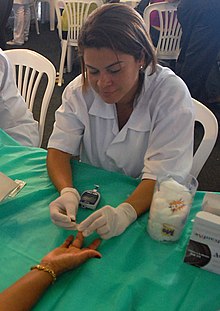Fingerstick (original) (raw)
From Wikipedia, the free encyclopedia
Capillary blood test
Blood glucose monitoring
In medicine, some blood tests are conducted on capillary blood obtained by fingerstick (or fingerprick) (or, for neonates, by an analogous heelprick). The site, free of surface arterial flow, where the blood is to be collected is sterilized with a topical germicide, and the skin pierced with a sterile lancet.[1] After a droplet has formed, capillary blood is captured in a capillary tube (usually relying on surface tension). Blood cells drawn from fingersticks have a tendency to undergo hemolysis, especially if the finger is "milked" to obtain more blood.[2]
Tests commonly conducted on the capillary blood collected are:
- Blood gas test – Fingerstick testing may be used for measuring blood gas tension values, blood pH, and the level and base excess of bicarbonate.
- Glucose levels – Diabetics often have a portable blood meter to check on their blood sugar.
- Lipid profile – Fingerstick testing may be used to find abnormalities in blood lipid (such as cholesterol and triglycerides) concentrations.
- Mononucleosis – Fingerstick testing can be used to test for mononucleosis.
- Hemoglobin levels – Fingerstick testing of hemoglobin is a quick screening procedure to ensure a blood or plasma donor has an acceptably high blood count for donating blood or blood components.
- Genetic testing – Heelprick testing of a newborn's DNA allows for early diagnosis and mitigation of common hereditary disorders.
- CBC
- Prothrombin time[3]
Fingersticks are routine for hardy[_citation needed_] adults, but are generally performed on children and the elderly only if a small amount of blood suffices for needed tests. Neonates are given heelpricks instead, as this is less likely to cause permanent damage.[_citation needed_]
- ^ Centers for Disease Control, Capillary blood sampling protocol (PDF)
- ^ Carreyrou, John (21 May 2018). "A New Look Inside Theranos' Dysfunctional Corporate Culture". Wired. Retrieved 23 May 2018.
- ^ Ansell, J.; Holden, A.; Knapic, N. (November 1989). "Patient Self-Management of Oral Anticoagulation Guided by Capillary (Fingerstick) Whole Blood Prothrombin Time". Arch Intern Med. 149 (11): 2509–11. doi:10.1001/archinte.1989.00390110085018. PMID 2818110.
- Heelpricks, section "Blood collection on babies"
